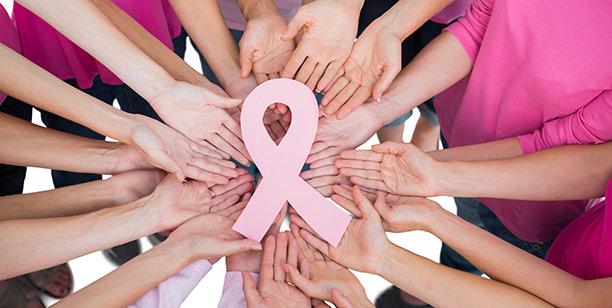
October is National Breast Cancer Awareness Month. This international health campaign was created in 1985 to increase awareness of the disease and help raise funds for research. Breast cancer is the second most common kind of cancer in women, second only to skin cancer. Every year in the U.S., more than 200,000 women are diagnosed with breast cancer. There are currently more than 2.9 million breast cancer survivors in the U.S. and about 1 in 8 women born in the U.S. today will be diagnosed with breast cancer at some point in their lives. However, in recent years there has been a gradual reduction in female breast cancer incident rates among women aged 50 and older, perhaps coinciding with the decline in prescriptive hormone replacement therapy after menopause.
The good news is that many women can survive breast cancer if it is found and treated early. While more than 40,000 women die from breast cancer each year in the U.S., early detection, increased awareness, and improvements in treatment options are preventing many more deaths. In fact, death rates have been declining since 1989, especially in women younger than 50. Survival rates are higher when the cancer is detected in the earlier stages.
The breast self-exam is a critical tool in the battle against breast cancer. According to the National Breast Cancer Foundation, 40 percent of diagnosed breast cancers are detected by women who feel a lump. Women are encouraged to perform a breast self-exam every month by feeling and looking for any abnormalities. Doing this monthly exam will help you know what is normal for you so that you can more easily detect any changes. A clinical breast exam is recommended at each doctor visit, either to a family physician or at your annual well woman exam, and should be performed by a healthcare professional who is trained to recognize different types of abnormalities and warning signs. Beginning at age 50, women also should receive a screening mammogram every two years.
Symptoms and signs of breast cancer include:
- A change in how the breast or nipple feels
- Nipple tenderness or a lump or thickening in or near the breast or underarm area
- A change in the skin texture or an enlargement of pores in the skin of the breast (some describe this as similar to an orange peel’s texture)
- A lump in the breast (It is important to remember that not all lumps are cancerous but it is important that every lump be investigated by your healthcare professional.)
- A change in how the breast or nipple feels
- Any unexplained change in the size or shape of the breast
- Dimpling anywhere on the breast
- Unexplained swelling of the breast, especially if it is on one side only
- Unexplained shrinking of the breast, especially if it is on one side only
- Recent asymmetry of the breasts (While it is common for women to have one breast that is slightly larger than the other, any recent or sudden onset of asymmetry needs to be checked.)
- A nipple that is turned slightly inward or inverted
- The skin of the breast, areola, or nipple becomes scaly, red, or swollen or may have ridges or pitting resembling the skin of an orange
- Any nipple discharge, especially clear or bloody discharge (While not linked to breast cancer, a milky discharge that is present when a woman is not breastfeeding should be checked by her doctor.)
Some people have no symptoms. Most people who do have breast cancer symptoms and signs will initially only notice one or two. The presence of these symptoms does not automatically mean that you have breast cancer. However, if you have any of these symptoms, it is important that you tell your healthcare provider so that the problem can be diagnosed and treated.
While you cannot prevent cancer, there are some habits that can help you reduce your risk, including:
- Maintain a healthy weight. Being overweight or obese after menopause increases your breast cancer risk by raising estrogen levels that come from fat tissue.
- Stay physically active. Exercise boosts your immune system. As little as 1.25 to 2.5 hours per week of brisk walking can reduce your risk of cancer by as much as 18 percent.
- Eat a healthy diet, including fruits and vegetables. A high-fat diet can trigger estrogen production that can fuel tumor growth. Consuming a low-fat diet will help reduce your cancer risk.
- Do not smoke. Smoking is not only a contributing factor for developing breast cancer, but it also directly contributes to heart and lung diseases.
Limit alcohol consumption. While one drink per day has been shown to only slightly increase the risk of breast cancer, having more than one drink per day has shown to be a more significant risk factor. Women who consume 2 to 5 alcoholic drinks per day have 1.5 times the risk of women who do not drink.








